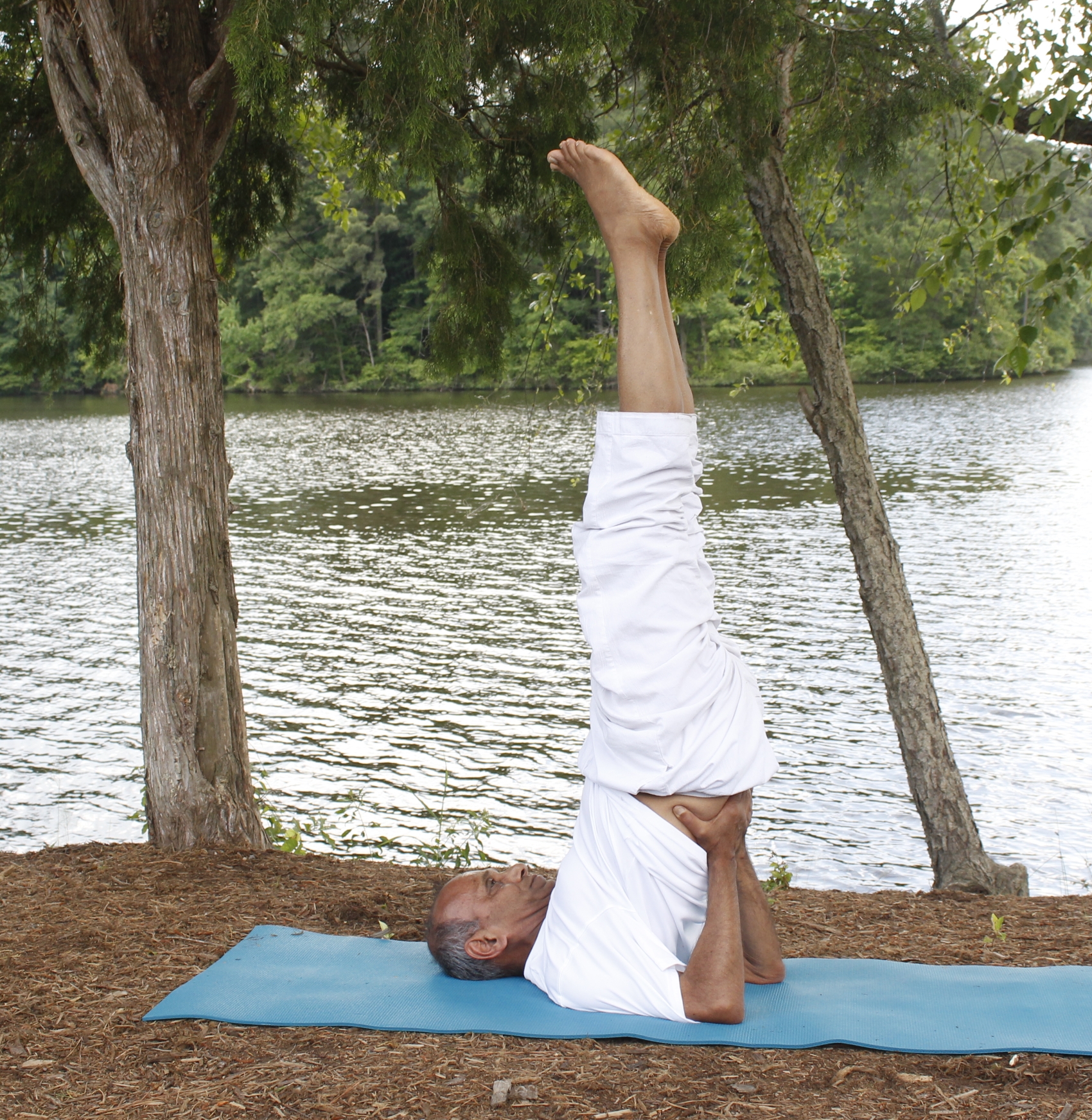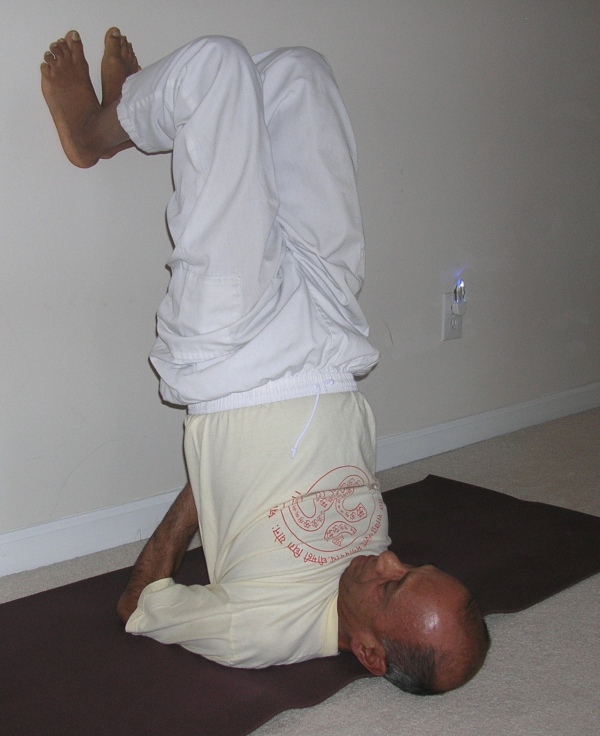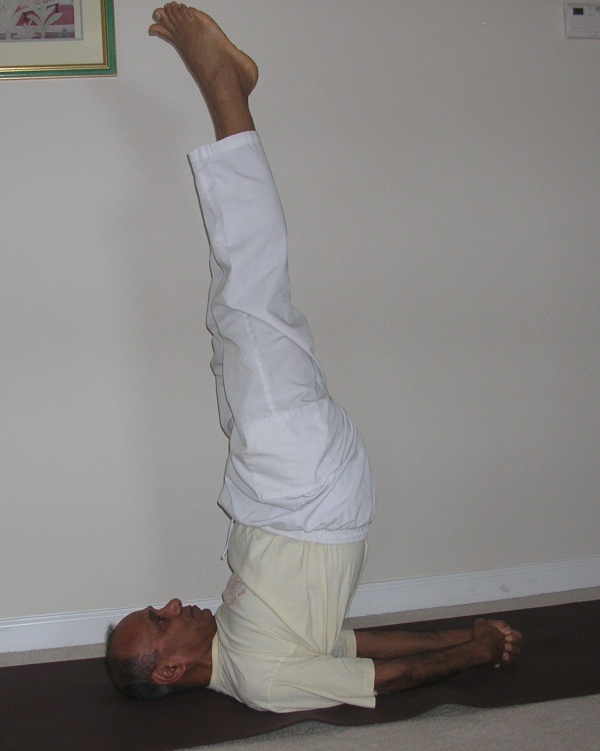In this article, we will be discussing one of the inverted poses, called Sarvangasana – सर्वाङ्गासन – (commonly translated as the Shoulder Stand or the Supported Shoulder Stand pose). In some yoga texts, this pose is called the "queen of the asanas" (the headstand or the shirShasana is generally referred to as the king of the asanas). The word "sarvangasana" can be broken into two words "sarvanga" and "asana". The word "sarvanga" is a compound word consisting of "sarva" meaning "all" and "anga" meaning "limbs". The word sarvanga implies that this pose when practiced regularly can bring benefits to your entire body. This beneficial effect is mainly achieved by harmonizing the endocrine system, in particular the thyroid and parathyroid glands.
Video Sequence
Step-by-Step
- Lie down with your back on a Yoga Mat, feet together. Place the arms alongside the body, palms facing down.
- Pressing with the palms, holding the breath, slowly raise the legs up to a 90 deg angle. Pause for a few seconds.
- At this point, pressing with the palms, lift your back and lower your legs overhead behind you until they are parallel to the floor.
- Try to keep the spine vertical and place your palms on the back, close to the shoulder blades, without widening the elbows.
- Use your hands to push the back forward with the result that it gets narrower and straighter and there is an increased pressure on your shoulders. At the same time, this requires more power of the muscles of the lower back. Rest your weight on the back side of the shoulders.
- Slowly raise the legs up to a full vertical position. In the final position of the pose, the heels, buttocks and the shoulders should be in a single vertical plane. The chest may make a soft contact with the chin.
- While maintaining the pose, keep the neck and shoulder muscles relaxed.
- After some time, try placing your arms a little lower in the direction of the shoulder blades on your back. See to it that the elbows do not stand too far apart. Breathe in and out quietly and try to find your balance.
- Experienced practitioners can try to hold the pose for about three minutes or even longer. However, if you feel any tension building up anywhere in the body, you may lower one leg at a time or lower both the legs slightly to release tension. You may come out of the pose completely if you begin to feel uncomfortable in the pose.
- To come out of the pose, lower both the legs down overhead until they are parallel to the floor. Place the palms on the floor and keeping a gentle pressure with the palms, begin to lower the back, one vertebra at a time, to the floor. When the tailbone touches the floor, start lowering the legs down slowly. Try to keep the legs straight and avoid lifting the head off the floor.
- Finally, rest in Shavasana for some time.
Modifications
For beginners who are not able to lift the torso up slowly, the following modifications are recommended:
- Align yourself alongside the wall in a seated position, legs stretched out.
- Slowly lower the back to the floor, keeping the body perpendicular to the wall, the buttocks almost touching the wall. Allow the head to rest on the floor.
- Bending the knees, push the feet firmly against the wall and lift the pelvic slowly up to a vertical position. Keep the neck and shoulders relaxed
- For a few weeks, while practicing this pose, you may want to keep the feet against the wall. When the neck and shoulder muscles gain strength, you may attempt to lift one leg at a time off the wall.
- When you feel comfortable, you may lift both the legs away from the wall and assume the full shoulder stand position.
- Some people are comfortable in the final position; however, they have difficulty getting into the position. In such cases, you may slowly rock the back up and down and get a "running jump" into the shoulder stand. Make sure not to strain the neck and shoulders in the process.
Variations
More experienced practitioners can try some of the following variations:
- While in the supported pose with the palms against the back, try to release the hands down to the floor and continue to hold the legs vertical without the hand support. You may clasp the hands together behind you on the floor. This is called the “Niralamba Sarvangasana” or “Unsupported Shoulder Stand”.
- You may attempt lowering one leg overhead (behind you) while keeping the other leg vertical. Hold this position for a few seconds, and then repeat on the other side.
- Finally, you may lower both the legs overhead in the full “halasana” or “plough pose”. In this pose, try to keep the legs straight and bring the feet as close to the floor as comfortable.
- You may attempt to get into the “padmasana” or the “lotus pose” while still in the sarvangasana. Hold this position for a duration that feels comfortable.
Benefits
A detailed description of the benefits of Sarvangasana, taken from the book, "A systematic course in the ancient tantric techniques of yoga and kriya", by Bihar School of Yoga is available here.
- tones the legs, buttocks, back, and core muscles
- stretches the shoulders and improves flexibility of upper spine
- calms the brain / nervous system and helps relieve stress
- improves digestion
- massages and stimulates the thyroid, parathyroid and prostate glands thus improving metabolism
- massages abdominal organs and improves digestion
- helps relieve the symptoms of menopause
- flushes mucous from the lungs
- Helpful in relieving asthma, hemorrhoids, hernia, and diabetes
Contraindications/Cautions
- neck or back problems
- heavy period of menstruation
- high blood pressure; if the blood pressure is controlled with medication, you may attempt the pose gradually, making sure that it does not cause an elevation in the blood pressure
- eye or inner ear infection
- pregnancy; if you have been a regular practitioner of this pose prior to getting pregnant, you may attempt the pose under the expert guidance of a qualified yoga teacher only. In general, however, pregnant women are strongly discouraged from practicing this pose.
- diarrhea
- Supported Sarvagasana is considered an intermediate to advanced posture. If you are new to Yoga, we recommend you start with the beginner variations suggested above and then gradually work your way towards the full variation.



Sir,
very very useful.
Please advise the resting position after doing sarvangasana.
as iam doing 4 reps but i am not clear about the resting position between each .
regards
prabhu
A good resting position would be the Shavasana. In my practice, I don’t do reps of sarvangasana, just once for about three minutes. I follow that with Matsyasana as the counter stretch. In your case, after the reps, you may still want to do the Matsyasana.
Hi
great blog . Learnt a lot .please do make a page for chakrasana
Hello Hari, I am so glad that you find the blog helpful. I certainly will try to write an article about Chakrasana soon! Thanks for the suggestion. I would love to hear more suggestions about what I should write about. Thanks.
[…] variation is simply an extension of the shoulder stand (sarvangasana). From the final position of the shoulder stand, begin to lower the legs overhead and follow the same […]
This is one of the best videos I have seen for Shoulder stand. The blog is superb. Thanks for sharing this information.
Dear Janaki,
Thanks a lot for your encouraging feedback. I would appreciate your comments on the other posts as well. If there is a specific topic that you would like me to discuss, please let me know.
Subhash
Great post! I’ll subscribe right now wth my feedreader software!
Hi, gr8 post thanks for posting. Information is useful!